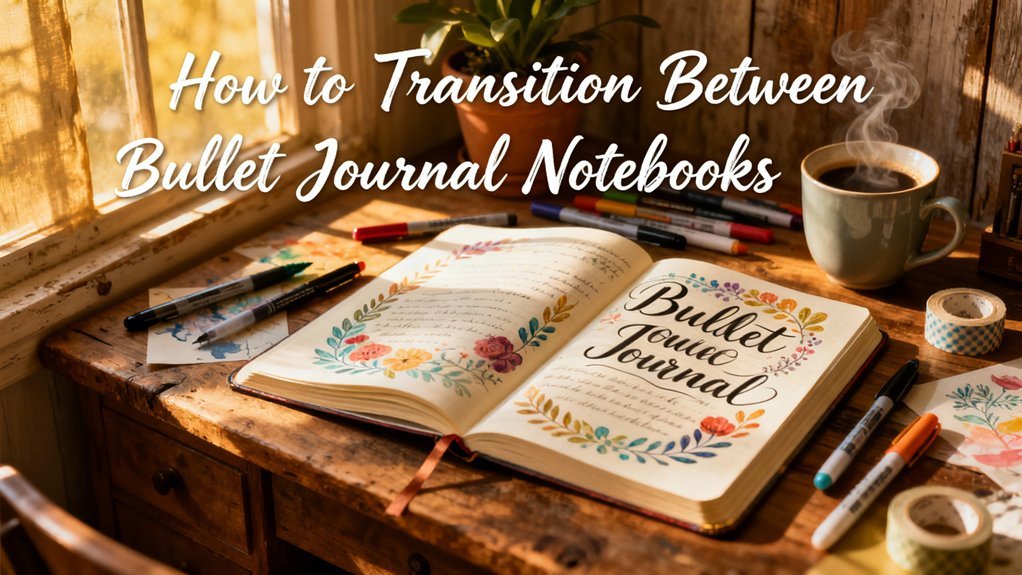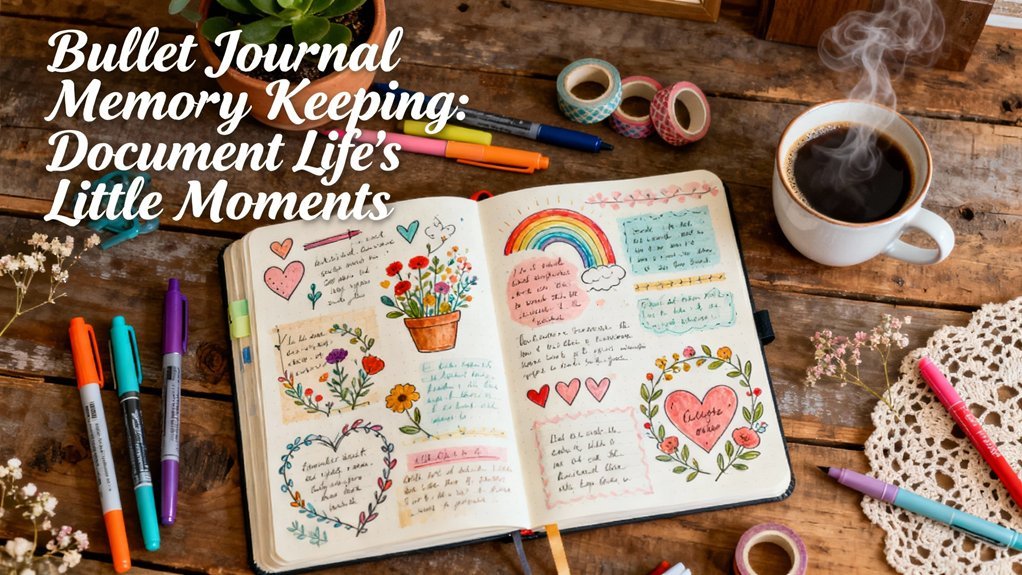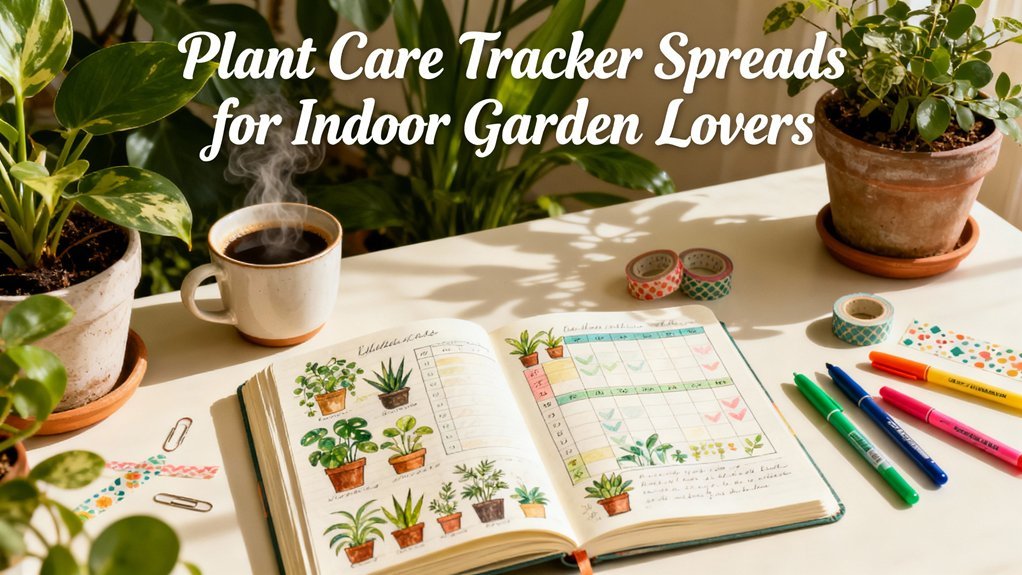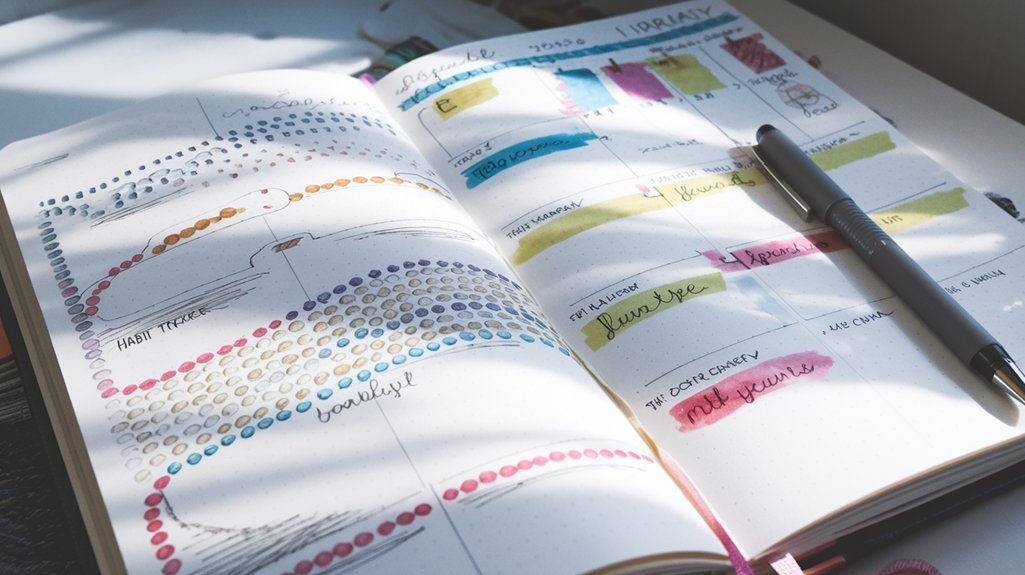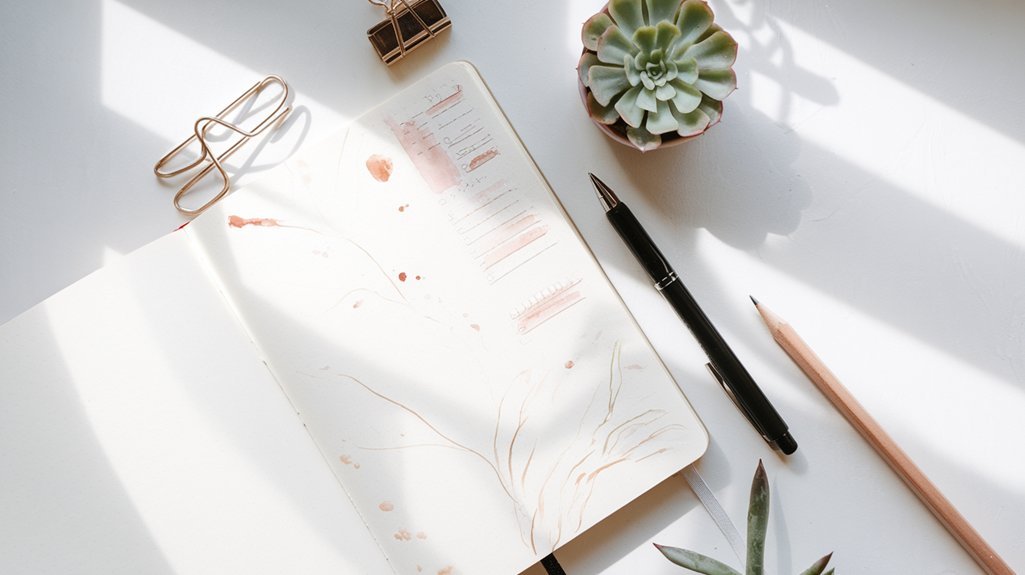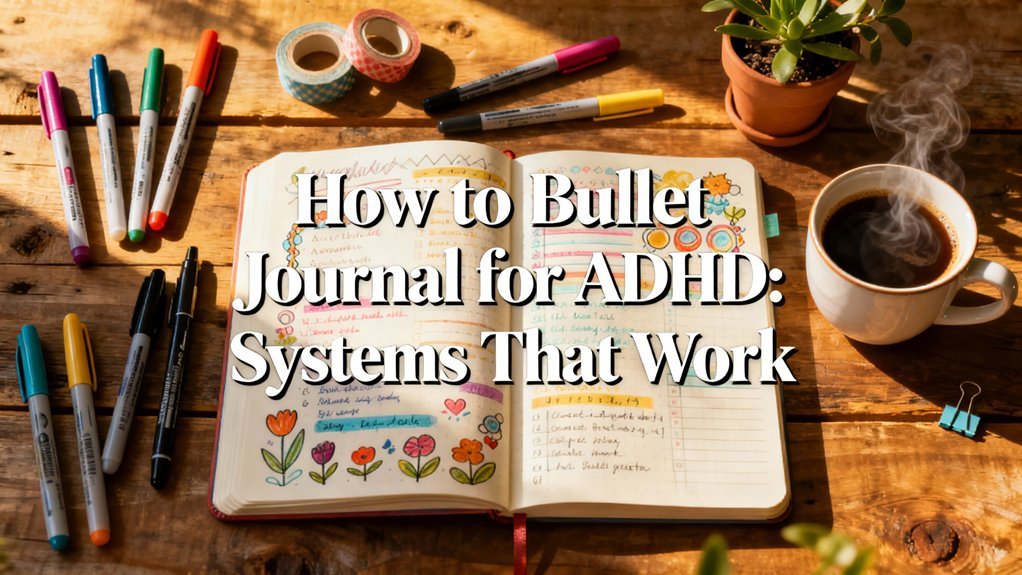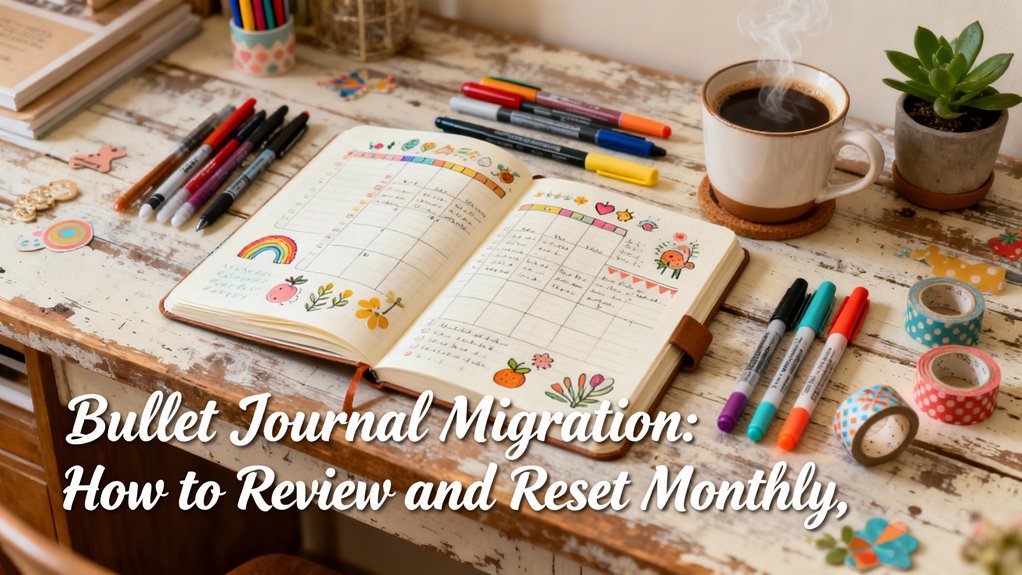Start by auditing your current journal to identify active collections, incomplete tasks, and habit trackers worth migrating. Use your final pages to create continuation markers and a master index, then photograph key spreads for reference. In your new notebook, establish a fresh index system and key before transferring essential pages with improved layouts. Store your completed journal with spine labels and dates for easy retrieval. This intentional shift process alters notebook changes into opportunities for design refinement and renewed creative focus.
Key Takeaways
- Audit your current journal to identify active tasks, projects, and trackers that need migration to the new notebook.
- Reserve index pages upfront and establish a clear key system with consistent symbols for tasks, events, and notes.
- Mark continuation pages in your old journal and create reference markers linking collections across both notebooks.
- Redesign underperforming habit trackers and consolidate multiple spreads into streamlined, motivating formats for the new journal.
- Archive completed journals with spine labels, photograph key spreads for digital backup, and store them vertically for preservation.
Audit Your Current Bullet Journal and Identify What to Migrate

Before you transfer a single page to your fresh notebook, spread out your current journal and assess what truly deserves the move. This critical evaluation maximizes bullet journal benefits while preventing visual clutter in your pristine setup.
Scan each spread with intention. Active projects demand migration—incomplete task lists, ongoing trackers, and collections you're actively referencing. Archive completed goals; they've served their purpose beautifully.
Migrate only what remains alive in your practice—active tasks and referenced collections earn their place in fresh pages.
Consider your notebook selection strategy moving forward. If you're switching formats or layouts, identify which modules translate well into your new spatial configuration. That habit tracker might need redesigning. Your color-coded system could evolve.
Create a migration shortlist. Document page numbers, collection titles, and design elements worth preserving. Photograph spreads you'll want to reference during setup.
This systematic approach guarantees your new journal inherits only what enhances your practice—not what weighs it down. Your fresh start deserves intentional curation. Remember that effective time management and productivity techniques emerge from keeping only the spreads and collections that actively serve your current goals.
Prepare Your Final Pages for Maximum Usefulness
The final pages of your closing notebook aren't an ending—they're a bridge.
Alter these last spreads into reference tools by crafting a thorough master index, marking where your collections continue into the next journal, and creating a visual snapshot of incomplete tasks.
This intentional design work guarantees nothing falls through the cracks while maintaining the aesthetic continuity between your old and new systems.
By taking time to clear mental clutter through this transition process, you create the clarity needed to begin your next notebook with focused intention rather than scattered remnants from the previous one.
Create Master Index Pages
Every collection, habit tracker, and project log you've carefully maintained deserves a final bow—and that's where master index pages convert your completed journal from a closed chapter into a reference tool you'll actually use.
Design your master index as a visual directory. Map each collection's page range with hierarchical typography—bold titles, lightweight page numbers. Color-code categories: finance in sage, wellness in terracotta, projects in graphite. This chromatic system accelerates retrieval across multiple bullet journal volumes.
Consider dual-column layouts that optimize density without sacrificing legibility. Leave strategic whitespace for breathing room. Add minimalist icons beside entries—tiny glyphs that telegraph content at a glance.
Photograph these pages before archiving. Digital backups guarantee your organizational architecture remains accessible when your completed notebook moves to the shelf.
Document Ongoing Collection Continuations
As your current journal approaches its final pages, unfinished collections demand bridge-building—clean handoffs that prevent momentum loss when you crack open your next notebook.
Smart collection strategies require intentional closure rituals that map what continues forward.
Implement these migration techniques for fluid changes:
- Create continuation markers using arrow symbols (→) with explicit page references to your new journal
- Photograph incomplete spreads before transferring—visual documentation preserves your original design intent
- Assign temporary page numbers in your next journal, then update references once layouts solidify
- Design a “Collections in Transit” index page listing every migrated spread with both old and new locations
These visual bridges change potentially chaotic handoffs into deliberate design moments.
Your collections maintain their narrative thread while evolving aesthetically across journals.
Note Unfinished Tasks Lists
Collections carry your creative vision forward, but individual tasks scattered throughout your closing journal pages tell a different story—one of incompleteness that requires visual reconciliation.
Before shifting to your new notebook, audit every spread for unfinished tasks. Create a consolidated index page that maps these outstanding items by priority level, using distinctive visual markers—color coding, iconography, or geometric boundaries—to distinguish between urgent completions and flexible timelines.
This task prioritization matrix becomes your transition blueprint, ensuring nothing falls through the cracks during migration.
Don't just copy tasks blindly; evaluate each item's continued relevance. Some tasks have expired naturally, while others demand immediate attention.
Your assessment process alters scattered obligations into an intentional, curated action plan that launches your fresh journal with purposeful momentum.
Set Up Your New Notebook's Index and Key System
Your new notebook's foundation begins with two essential systems: the index and the key. These structural elements convert blank pages into an intelligent, navigable system that adapts with your needs.
Start with index organization across your first spread. Reserve 2-4 pages, creating clean columns for page numbers, collection names, and visual markers. This energetic map grows as your journal develops, ensuring instant access to any content.
Next, establish your key symbols—the visual language that makes rapid logging possible:
- Tasks: Simple dots that migrate through states (complete, migrated, canceled)
- Events: Circles for time-specific occurrences worth tracking
- Notes: Dashes for observations and information capture
- Priority markers: Asterisks or exclamation points for urgent items
Design your key with intention. Choose symbols that feel intuitive and maintain visual consistency. Position it prominently—inside covers work brilliantly—so you'll reference it seamlessly until the system becomes second nature.
Transfer Essential Collections and Reference Pages

Migration breathes life into your most valuable pages, carrying forward only what serves your current reality. Curate your essential collections with intention—books to read, habit trackers, savings goals—transferring only active entries that align with your evolving vision.
Archive completed items in your old journal; they've earned their rest.
Your reference pages deserve thoughtful redesign during change. Password logs, measurement charts, and frequently-accessed information gain fresh visual hierarchy in their new home. Consider upgrading layouts with improved spatial organization or color-coded systems that improve functionality.
Document your transfer decisions through a migration log—a meta-collection tracking what moved forward and why. This practice sharpens your curatorial eye, revealing patterns in what genuinely matters versus what accumulated through habit.
Photograph pages you're leaving behind if sentiment tugs at you. Digital backup liberates space while honoring your creative evolution. Your new notebook becomes a refined reflection of present priorities.
Maintain Tracking Continuity Across Notebooks
Your tracking systems need visual consistency to maintain their momentum across notebook shifts.
Start by recreating your active habit trackers with the same color codes, symbols, and layout structure you've established—this visual continuity helps your brain recognize patterns instantly.
Simultaneously transfer your ongoing collection lists, preserving their formatting while marking which items have been completed and which still need attention.
Transfer Active Habit Trackers
When you flip to a fresh notebook, your habit trackers deserve the same thoughtful migration as your tasks and collections. You'll want to evaluate which habits truly matter before recreating them in your new space.
Consider these habit tracking strategies for your change:
- Analyze your completion rates from the previous notebook to identify which habits stick
- Redesign non-performing trackers with fresh layouts that spark motivation
- Consolidate multiple trackers into efficient, space-efficient formats
- Experiment with new visual systems like minimalist dots, gradient fills, or geometric patterns
Your tracker design ideas should evolve with each notebook iteration. Strip away decorative elements that don't serve function.
Embrace white space. Let form follow your actual tracking behavior, creating systems that feel smooth rather than obligatory.
Migrate Ongoing Collection Lists
Collection lists—those curated compilations of books to read, films to watch, gift ideas, or project inspiration—form the living archive of your bullet journal.
When changing notebooks, evaluate which ongoing collections warrant migration. Transfer active lists with uncompleted items, leaving behind exhausted references.
Design your new spreads with refined aesthetics—perhaps you'll introduce color-coding systems or minimalist dividers that weren't present before. Don't simply replicate; reimagine.
Consider consolidating fragmented collections or splitting overgrown lists into focused categories. Photograph completed pages from your old bullet journal before archiving, creating a digital backup of accumulated wisdom.
This movement moment offers the perfect opportunity to audit what truly serves your current vision, ensuring only purposeful, relevant ongoing collections occupy premium space in your fresh notebook.
Archive Your Completed Journal for Future Reference

A finished bullet journal deserves more than a spot on a dusty shelf—it's a visual archive of your daily rituals, evolving aesthetics, and creative experiments.
Preserve its value through intentional journal storage and strategic digital archiving methods that honor your creative investment.
Intentional storage and digital archiving transform your bullet journal from ephemeral notebook into preserved creative artifact.
Consider these archival approaches to maintain accessibility:
- Photograph signature spreads that showcase your design evolution, layout innovations, and stylistic breakthroughs.
- Scan completed trackers to analyze behavioral patterns and inform future system refinements.
- Store journals vertically with spine labels indicating date ranges for instant visual retrieval.
- Create digital backups of essential reference pages using scanning apps with OCR capabilities.
Label each journal's spine with start and end dates, volume numbers, or thematic identifiers.
Store them in climate-controlled spaces away from direct sunlight to prevent deterioration.
Your archived journals become a design portfolio—tangible evidence of your creative progression and methodological refinement over time.
Frequently Asked Questions
How Often Should I Transition to a New Bullet Journal Notebook?
You'll shift when your notebook's filled or when you're craving fresh aesthetics—there's no rigid timeline.
Monthly shifts work beautifully if you're drawn to constant reinvention and evolving layouts. However, personal preference reigns supreme here.
Some creators maintain their journals for six months, savoring a cohesive visual narrative, while others crave quarterly refreshes for design experimentation.
Let your creative instincts guide you. When your current spreads no longer spark joy or innovation, it's time to curate something new.
What's the Best Notebook Size for Bullet Journaling?
The best notebook size depends on your personal preferences and lifestyle needs. A5 (5.8″ × 8.3″) offers the perfect balance—portable yet spacious enough for creative spreads.
Consider notebook dimensions that complement your aesthetic vision: pocket-sized for minimalists, larger formats for visual artists.
You'll want a canvas that inspires your design sensibility while fitting effortlessly into your daily routine.
Test different sizes to discover which dimensions enhance your journaling experience and spark innovation in your layouts.
Should I Finish All Pages Before Transitioning to a New Notebook?
You don't need to exhaust every page before switching notebooks—your page usage should align with your creative vision, not arbitrary completion.
If your current spreads no longer inspire you or your notebook preferences have evolved, shift freely.
Consider altering remaining pages into a visual archive or testing ground for experimental layouts.
Your bullet journal's a living canvas, and forcing outdated designs compromises its aesthetic integrity.
Innovation thrives when you're designing within spaces that genuinely excite you.
Can I Use Different Notebook Brands When Transitioning Bullet Journals?
You're absolutely free to switch notebook brands—there's no notebook compatibility requirement!
Your bullet journal system adapts beautifully across different formats. Embrace this opportunity to explore brand preferences and discover what enhances your creative process.
Perhaps you'll gravitate toward minimalist grid layouts, textured covers, or cutting-edge paper stocks. Each shift becomes a visual refresh, allowing you to reimagine your spreads with fresh design possibilities.
Let aesthetics guide your choice and watch your journaling practice develop.
How Do I Choose Between Lined, Dotted, or Blank Pages?
Choose based on your page preferences and how they'll improve your layout styles.
Dotted pages offer subtle guidance without overwhelming your designs—they're perfect for creating clean spreads while maintaining creative freedom.
Lined pages work if you're text-heavy and want consistent writing flow.
Blank pages give you unlimited artistic potential but require confident spatial planning.
Consider photographing your current spreads on each format to visualize which foundation best showcases your evolving aesthetic and supports your groundbreaking journaling approach.
Conclusion
You've honored your old journal's journey. You've curated what matters. You've designed fresh pages with intention. Now, close that filled notebook with gratitude—its ink-stained pages hold your evolution. Open the new one with anticipation—its blank spreads await your vision. Between these two moments lives the art of thoughtful change: respecting what was, releasing what's complete, reimagining what's ahead. Your bullet journal practice doesn't restart; it evolves, carrying forward only the layouts, systems, and beauty that truly serve you.

